Goal
To understand "grid" as both a regulating system
and as an aid to "scale" change; to introduce the concepts of "size," "scale," and "proportion" as it relate to two-dimensional design
Ron Mueck


Discussion
A "system" is simply an orderly way of doing something. Art that seems to result from the application of a specific procedure, from repeated use of a pattern or set of patterns, or from adherence to a body of rules is sometimes
referred to as "systemic art" or "systems" art.

 koons
koonsA "grid" is understood, in most instances, as a system of fixed horizontal and vertical divisions. Grids are among the most adaptable and universally applicable of all systems. Any flat shape, no matter how irregular, can be conceived of in terms of what coordinate geometers would call X (horizontal) and Y (vertical) axes. The mechanical regularity of a grid can be used as an aid in copying, in scale or proportional changes, or to reveal complicated relationships within a work of art.

 michaelangelo
michaelangelo"Size" is a quantitative description of an object that only makes sense in relationship to either another object or an agreed upon standard of measurement. (e.g., something is "big" only in relationship to something already agreed to be "small.") Scale and Proportion create two type of size relationship. Both strongly affect compositional balance and emotional impact.
"Proportion" refer to the relative size of visual elements within an image.
"Scale" commonly refers to the size of a form when compared with our own human size. Thus, a 50-foot-long painting is a large-scale artwork, while a 10-square-inch square painting is an example of small scale.
Scale is a proportional relationship between two sets of dimensions. In general, "scale" refers to the mathematical relationship between an object and a measurable quantity (the scale referent). We say that an object is "full-scale" when it corresponds 1:1 with real life. If the same object is rendered such that any given linear dimension is one-half the length of the original object, we understand this to be at "half scale" or 1 :2. One quarter the length would be "quarter scale", 1 :4, or 1/4th scale.
Vocabulary:
system, grid, size, scale, proportion
Using Grids for Scale Translation
If you want to translate an image to a a different scale, a grid can be a useful tool.
Sample Problem: Blow up this image by a factor of four (4x). (Imagine the image as being 10" vertically x 8" horizontally)

1) On a piece of clear acetate (at least 8 x 10 inches), create a grid of evenly spaced (1 ") horizontal and vertical ruled lines. Use a "Sharpie" or similar permanent marker. Label each division of the horizontal (X) axis across the top with numbers 1 through 8. Label each division of the vertical axis (Z) with letters (A through J).
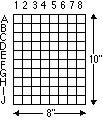
2) Overlay the gridded acetate over your original artwork. Secure with drafting tape. You will quickly see that the major features of the image will correspond to "locations" (defined by their relationship to the X and Y axes) that fall on or near lines of the grid.
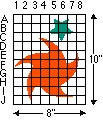
3) Using an "erasable marker" (so you can reuse your grid), trace the major outlines and features of the artwork onto the acetate. Make "tick marks" where your lines cross the lines of the grid.
4) Now create a light grid in pencil on the canvas or surface of your blow-up. We know you want the image to be 4 times its original size. You would make a grid on your canvas 4x the size of your acetate grid--that is, 40 inches high and 32 inches wide. Each subdivision of the grid would be 4 " across.
5) Carefully translate the "tick marks" from your acetate grid to the grid on the new artwork. By estimating relative distances, you can get a very accuate translation. For example, if a tick mark on the original (let's say the upper left point of the green star) is "about in the center of square A5," you would place a tick mark on the blow-up about in the center of A5.
6) Faithful adherence to the original will ensure an accurate scale translation. Once you have located all the points of intersection, you simply need to connect the dots. You might do this freehand...establishing appropriate curvatures etc. by referencing to the original. If you need more "resolution" in the larger drawing, go back to your acetate grid and add a set of subdivisions at 1/2" intervals. Following the rule that what ever you do at one scale, you must do at the other, you would add a set of lines at 2" intervals on your larger artwork. Note: You needn't do this over the entire image. You may only need extra reference lines in areas of great detail--a face for example. You could have a small section of the original that had a very fine grid--say 1/4" intervals (which would be 1" intervals on the scaled up artwork).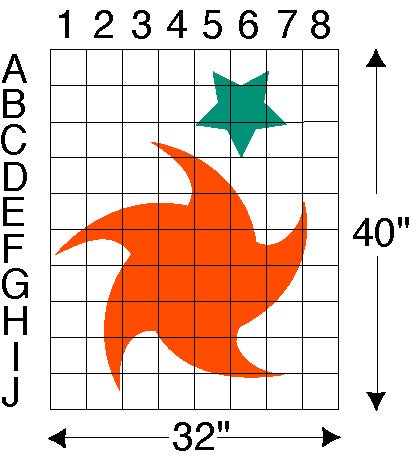 |  |


The image on the left is 4 inches high. The image on the right is 2 inches high--it has been scaled by .50 (4 inches x .50 = 2 inches)
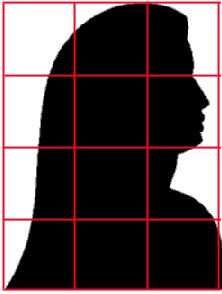
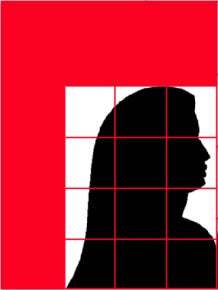
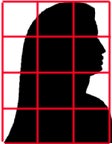
a) Create a composition that includes the following: a simple silhouette of a object" at "full scale;" a transformation of the object into"quarter-scale;" a "blow-up" ,the object to at 1 east 2:1. Go beyond this to make a composition that is conceptually and aesthetically pleasing creating a design that illustrates transformation of scale and proportion.





